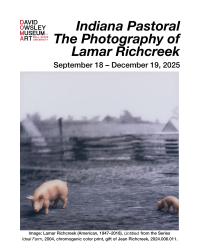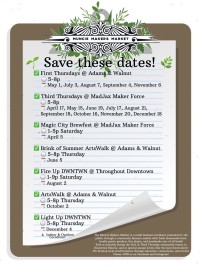5 upcoming events with the photography tag
424 past events with this tagDec 16, 2025
Today
-
 Indiana Pastoral: The Photography of Lamar Richcreek
9am to 4:30pm @
David Owsley Museum of Art, Ball State University
2021 W. Riverside Ave., Ball State University
Indiana Pastoral: The Photography of Lamar Richcreek
9am to 4:30pm @
David Owsley Museum of Art, Ball State University
2021 W. Riverside Ave., Ball State University
 Image: Lamar Richcreek (American, 1947–2018), Untitled from the Series Ideal Farm, 2004, chromogenic color print, gift of Jean Richcreek, 2024.006.011.
Image: Lamar Richcreek (American, 1947–2018), Untitled from the Series Ideal Farm, 2004, chromogenic color print, gift of Jean Richcreek, 2024.006.011.
September 18 – December 19, 2025
Ball State alumnus Lamar Richcreek (1947–2018) earned a degree in business administration in 1969. After a 24-year career in banking, he launched a second career in photography. In his 50s, he returned to school, earned an MFA at Vermont College of Fine Arts, and taught for 20 years as an adjunct professor of photography at the Herron School of Art + Design in Indianapolis. His success as a fine art photographer resulted in a solo exhibition at the Indianapolis Museum of Art in 2002.
Like the pastoral genre in literature, art, and music, Lamar Richcreek’s photographs often present nostalgic visual stories of Indiana’s agricultural landscape inflected by his business perspective. He once wrote in an artist’s statement, “My views of the landscape, agriculture and the family farm are romanticized ones, originating from childhood experiences and visits to my grandfather’s farm in Central Indiana. In the aftermath of World War II and during the Cold War years, the Midwest saw the creation of global markets for farm products and the development of technological advances that were invented to increase production for improved and insured profitability, all of which transformed American farming. These transformations favored agri-businesses and multi-national corporations, thereby altering the viability of the traditional family farm. This change occurred over time without my realizing its impact.”
Lamar Richcreek’s photography testifies to the effects of the post-war economic-agricultural boom in the Midwest through his images with surreal settings, witty juxtapositions, and sublime scenery. A recent donation of art from his wife, Jean Richcreek (1948–2025), to the David Owsley Museum of Art allows subsequent generations to view the corporatization of farming in Indiana through Lamar Richcreek’s creative lens. We are also grateful to Ball State alumnus Thomas Murphy (‘69) for his recent philanthropic investment in DOMA in memory of Lamar and Jean Richcreek.
Dec 17, 2025
Tomorrow
-
 Indiana Pastoral: The Photography of Lamar Richcreek
9am to 4:30pm @
David Owsley Museum of Art, Ball State University
2021 W. Riverside Ave., Ball State University
Indiana Pastoral: The Photography of Lamar Richcreek
9am to 4:30pm @
David Owsley Museum of Art, Ball State University
2021 W. Riverside Ave., Ball State University
 Image: Lamar Richcreek (American, 1947–2018), Untitled from the Series Ideal Farm, 2004, chromogenic color print, gift of Jean Richcreek, 2024.006.011.
Image: Lamar Richcreek (American, 1947–2018), Untitled from the Series Ideal Farm, 2004, chromogenic color print, gift of Jean Richcreek, 2024.006.011.
September 18 – December 19, 2025
Ball State alumnus Lamar Richcreek (1947–2018) earned a degree in business administration in 1969. After a 24-year career in banking, he launched a second career in photography. In his 50s, he returned to school, earned an MFA at Vermont College of Fine Arts, and taught for 20 years as an adjunct professor of photography at the Herron School of Art + Design in Indianapolis. His success as a fine art photographer resulted in a solo exhibition at the Indianapolis Museum of Art in 2002.
Like the pastoral genre in literature, art, and music, Lamar Richcreek’s photographs often present nostalgic visual stories of Indiana’s agricultural landscape inflected by his business perspective. He once wrote in an artist’s statement, “My views of the landscape, agriculture and the family farm are romanticized ones, originating from childhood experiences and visits to my grandfather’s farm in Central Indiana. In the aftermath of World War II and during the Cold War years, the Midwest saw the creation of global markets for farm products and the development of technological advances that were invented to increase production for improved and insured profitability, all of which transformed American farming. These transformations favored agri-businesses and multi-national corporations, thereby altering the viability of the traditional family farm. This change occurred over time without my realizing its impact.”
Lamar Richcreek’s photography testifies to the effects of the post-war economic-agricultural boom in the Midwest through his images with surreal settings, witty juxtapositions, and sublime scenery. A recent donation of art from his wife, Jean Richcreek (1948–2025), to the David Owsley Museum of Art allows subsequent generations to view the corporatization of farming in Indiana through Lamar Richcreek’s creative lens. We are also grateful to Ball State alumnus Thomas Murphy (‘69) for his recent philanthropic investment in DOMA in memory of Lamar and Jean Richcreek.
Dec 18, 2025
This Thursday
-
 Indiana Pastoral: The Photography of Lamar Richcreek
9am to 4:30pm @
David Owsley Museum of Art, Ball State University
2021 W. Riverside Ave., Ball State University
Indiana Pastoral: The Photography of Lamar Richcreek
9am to 4:30pm @
David Owsley Museum of Art, Ball State University
2021 W. Riverside Ave., Ball State University
 Image: Lamar Richcreek (American, 1947–2018), Untitled from the Series Ideal Farm, 2004, chromogenic color print, gift of Jean Richcreek, 2024.006.011.
Image: Lamar Richcreek (American, 1947–2018), Untitled from the Series Ideal Farm, 2004, chromogenic color print, gift of Jean Richcreek, 2024.006.011.
September 18 – December 19, 2025
Ball State alumnus Lamar Richcreek (1947–2018) earned a degree in business administration in 1969. After a 24-year career in banking, he launched a second career in photography. In his 50s, he returned to school, earned an MFA at Vermont College of Fine Arts, and taught for 20 years as an adjunct professor of photography at the Herron School of Art + Design in Indianapolis. His success as a fine art photographer resulted in a solo exhibition at the Indianapolis Museum of Art in 2002.
Like the pastoral genre in literature, art, and music, Lamar Richcreek’s photographs often present nostalgic visual stories of Indiana’s agricultural landscape inflected by his business perspective. He once wrote in an artist’s statement, “My views of the landscape, agriculture and the family farm are romanticized ones, originating from childhood experiences and visits to my grandfather’s farm in Central Indiana. In the aftermath of World War II and during the Cold War years, the Midwest saw the creation of global markets for farm products and the development of technological advances that were invented to increase production for improved and insured profitability, all of which transformed American farming. These transformations favored agri-businesses and multi-national corporations, thereby altering the viability of the traditional family farm. This change occurred over time without my realizing its impact.”
Lamar Richcreek’s photography testifies to the effects of the post-war economic-agricultural boom in the Midwest through his images with surreal settings, witty juxtapositions, and sublime scenery. A recent donation of art from his wife, Jean Richcreek (1948–2025), to the David Owsley Museum of Art allows subsequent generations to view the corporatization of farming in Indiana through Lamar Richcreek’s creative lens. We are also grateful to Ball State alumnus Thomas Murphy (‘69) for his recent philanthropic investment in DOMA in memory of Lamar and Jean Richcreek.

 Third Thursdays with the Muncie Makers Market
5pm to 8pm @
MadJax Maker Force
515 East Main Street Muncie, In 47305
Third Thursdays with the Muncie Makers Market
5pm to 8pm @
MadJax Maker Force
515 East Main Street Muncie, In 47305
THIRD THURSDAYS! 🌱 Join our local Growers & Makers of the Muncie Makers Market for a really fun "night market" vibe EVERY MONTH for Third Thursdays at MadJax Maker Force! ALL INDOORS! While you enjoy shopping for our homemade, handmade, and locally grown goods, you can also have a great time throwing axes and nerf football bowling with a beer at Max Axe Muncie, have a delicious dinner and brews at The Guardian Brewery Co., and explore the HUGE MadJax Maker Force facility! WE are soooo excited to partner with MadJax Maker Force for a NEW NIGHT OUT in Downtown Muncie!
The Muncie Makers Market is a retail business incubator presented to the public through a community farmers market with fresh homemade food, locally grown produce, live plants, and handmade arts of all kinds! You’ll find the Muncie Makers Market monthly during the First Thursday & Third Thursday community events in Downtown Muncie, and at special annual events like the Magic City Brewfest, Brink of Summer ArtsWalk, Fire Up DWNTWN, ArtsWalk, and Light Up DWNTWN throughout our community all year! We develop local small business through education, connections, and events! Please JOIN us on Facebook and Instagram and please SHARE: https://www.facebook.com/groups/1627047027524961/
MadJax Maker Force:
Mad Axe Muncie:
The Guardian Brewing Co.:
Dec 19, 2025
This Friday
-
 Indiana Pastoral: The Photography of Lamar Richcreek
9am to 4:30pm @
David Owsley Museum of Art, Ball State University
2021 W. Riverside Ave., Ball State University
Indiana Pastoral: The Photography of Lamar Richcreek
9am to 4:30pm @
David Owsley Museum of Art, Ball State University
2021 W. Riverside Ave., Ball State University
 Image: Lamar Richcreek (American, 1947–2018), Untitled from the Series Ideal Farm, 2004, chromogenic color print, gift of Jean Richcreek, 2024.006.011.
Image: Lamar Richcreek (American, 1947–2018), Untitled from the Series Ideal Farm, 2004, chromogenic color print, gift of Jean Richcreek, 2024.006.011.
September 18 – December 19, 2025
Ball State alumnus Lamar Richcreek (1947–2018) earned a degree in business administration in 1969. After a 24-year career in banking, he launched a second career in photography. In his 50s, he returned to school, earned an MFA at Vermont College of Fine Arts, and taught for 20 years as an adjunct professor of photography at the Herron School of Art + Design in Indianapolis. His success as a fine art photographer resulted in a solo exhibition at the Indianapolis Museum of Art in 2002.
Like the pastoral genre in literature, art, and music, Lamar Richcreek’s photographs often present nostalgic visual stories of Indiana’s agricultural landscape inflected by his business perspective. He once wrote in an artist’s statement, “My views of the landscape, agriculture and the family farm are romanticized ones, originating from childhood experiences and visits to my grandfather’s farm in Central Indiana. In the aftermath of World War II and during the Cold War years, the Midwest saw the creation of global markets for farm products and the development of technological advances that were invented to increase production for improved and insured profitability, all of which transformed American farming. These transformations favored agri-businesses and multi-national corporations, thereby altering the viability of the traditional family farm. This change occurred over time without my realizing its impact.”
Lamar Richcreek’s photography testifies to the effects of the post-war economic-agricultural boom in the Midwest through his images with surreal settings, witty juxtapositions, and sublime scenery. A recent donation of art from his wife, Jean Richcreek (1948–2025), to the David Owsley Museum of Art allows subsequent generations to view the corporatization of farming in Indiana through Lamar Richcreek’s creative lens. We are also grateful to Ball State alumnus Thomas Murphy (‘69) for his recent philanthropic investment in DOMA in memory of Lamar and Jean Richcreek.
-
-

